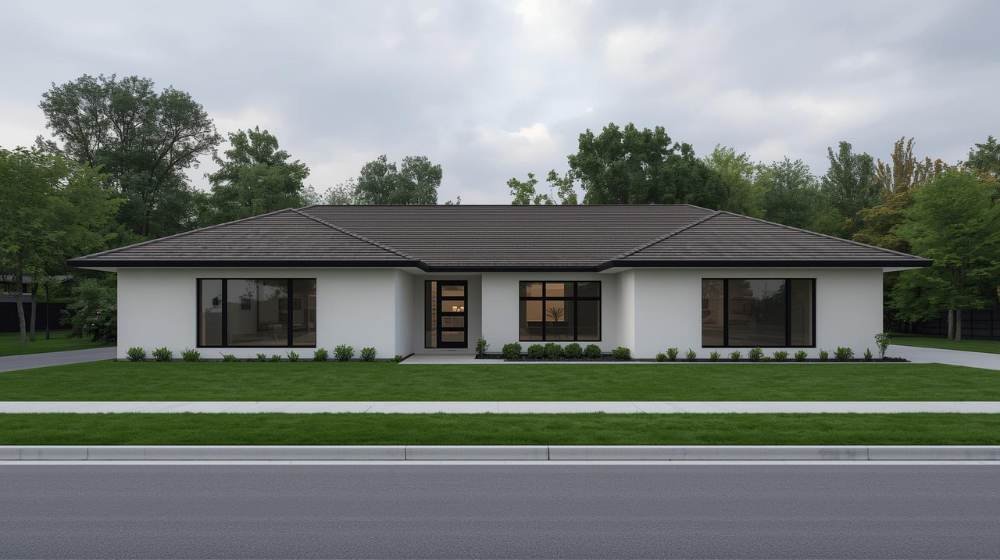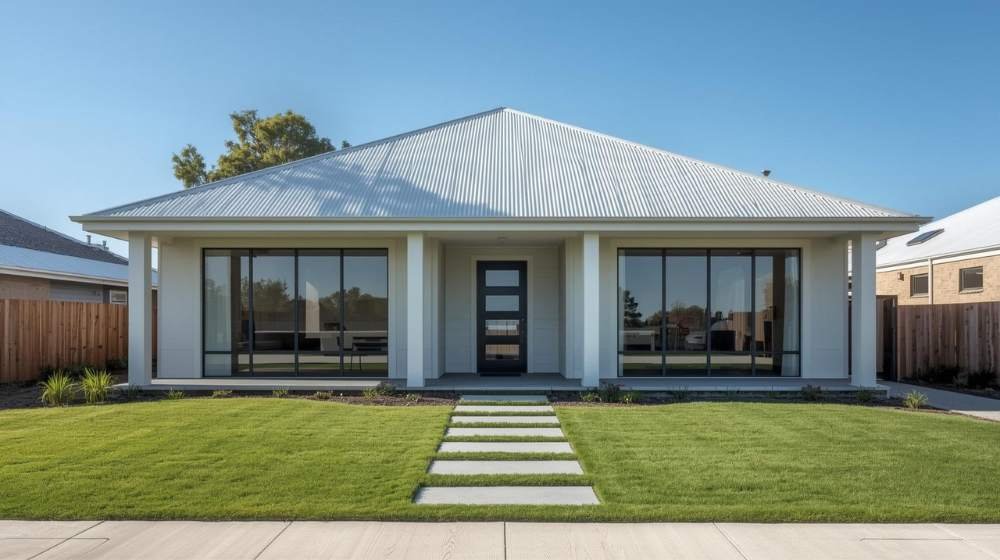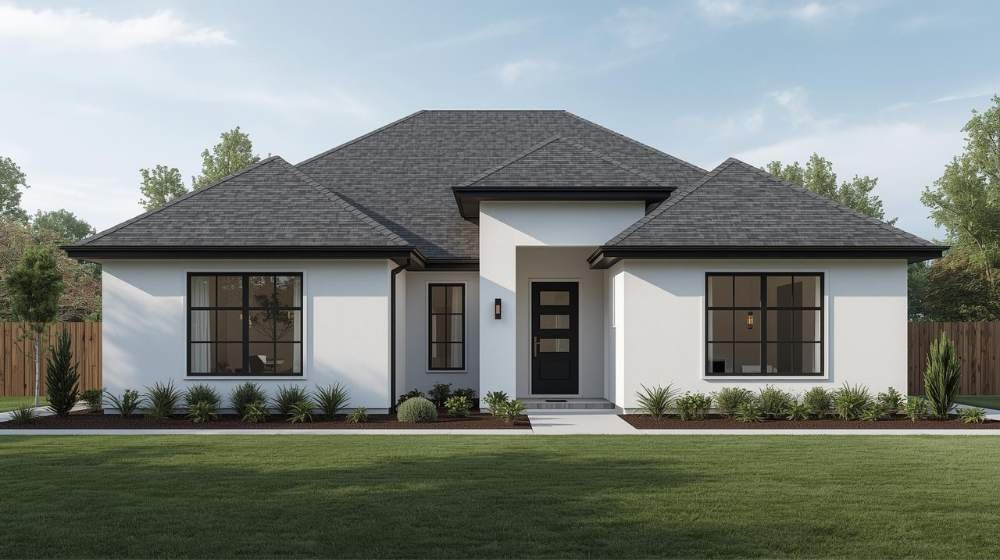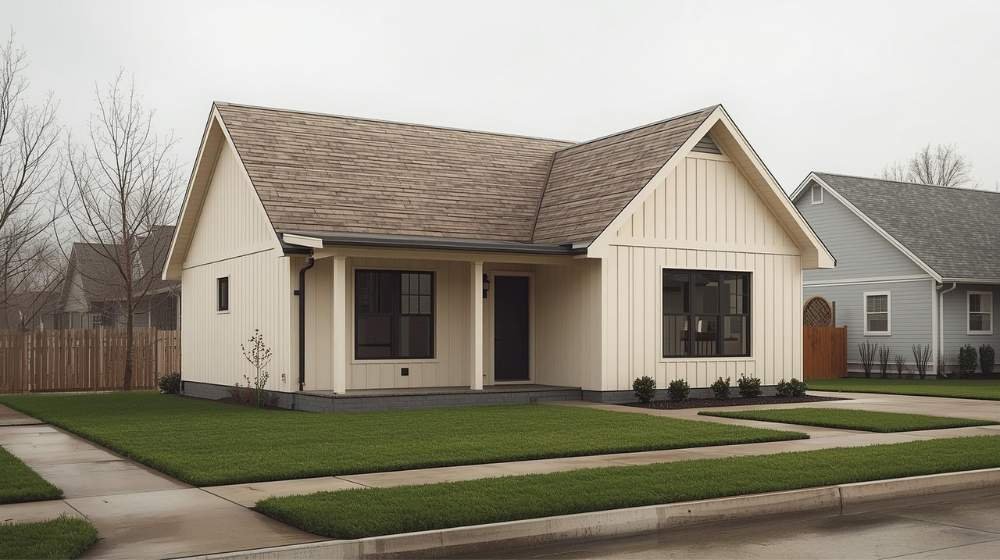Have you ever thought about which roof style is best for your Brooklyn home: a hip roof or a gable roof? The decision might seem easy at first, but once you consider the climate, variations, and durability, the question becomes a little more complicated. Choosing the right roof is not only about how it looks; it’s about how well it will protect your home against Brooklyn’s harsh weather and storms.
Now, I know you’re probably thinking, “How can I be sure which roof suits my home?” Well, that’s exactly what we’re going to tell you today! In this post, we’ll break down the key differences between hip roofs and gable roofs: from design and cost to maintenance and environmental impact.
By the end of this discussion, you’ll have a clear understanding of both roof types and be able to decide which one best fits your needs.

Quick View of Key Differences Between Hip Roof vs Gable Roof
| Feature | Hip Roof | Gable Roof |
| Design | All sides slope towards the walls. | Two sloped sides meet at a central ridge. |
| Wind Resistance | More stable, better for high winds. | Can be less stable in strong winds. |
| Snow and Rain Drainage | Excellent drainage, less chance of snow build-up. | Good drainage but more prone to ice dams. |
| Aesthetic Appeal | Symmetrical and sleek design. | Traditional, often found in classic homes. |
| Cost of Installation | More expensive due to complexity. | Generally cheaper and easier to install. |
| Maintenance | Requires more maintenance due to complex design. | Easier to maintain with fewer parts. |
| Durability | Generally lasts longer due to stability. | May suffer wear at the ridge and corners. |
What is a hip roof?
A hip roof is a roof design where all four sides slope down towards the walls. It has no gables or vertical sides, which gives it a symmetrical, pyramid-like shape. Hip roofs are known for their stability, which makes them more resistant to high winds. This design is often preferred in areas with severe weather conditions, such as strong winds or heavy snowfall.
12 Key Differences Between Hip Roof and Gable Roof
When choosing between a hip roof and a gable roof, it’s important to understand how each one works. While a hip roof has all sides sloping towards the walls, a gable roof has two sides that slope down and join at a ridge. The hip roof offers more stability, while the gable roof is easier and cheaper to install. In the following sections, we will examine the details of the differences in design, cost, maintenance, and other factors to help you determine which option is best for your Brooklyn home.
Variations of Designs of Gable vs Hip Roof
Every roof design has its unique style and variations. The design of your roof can impact the overall look of your home and its ability to withstand weather conditions. Let’s take a look at 5 popular variations for both gable and hip roofs:
Gable Roof Designs
- Front Gable: This design features a triangular gable at the front of the house. It’s one of the most traditional roof types. Front gables give homes a classic, symmetrical look. It’s simple to build, but it may be prone to wind damage if not properly constructed.
- Cross Gable: This design features two intersecting gable roofs at a right angle. It’s a popular choice for homes with multiple sections or wings. It allows for more interior space but can be a bit trickier to install.
- Dutch Gable: A combination of a gable and hip roof, this design features a small gable on top of a hip roof. It’s perfect for adding extra space or making your roof stand out. It provides both the stylish benefits of a gable and the stability of a hip roof.
- Saltbox Gable: The saltbox gable features one long side and one shorter side, which creates a more asymmetrical look. It’s often used in homes with a historical style. The design is renowned for its practicality, particularly in regions where snow accumulation can be substantial.
- Open Gable: This is a simple gable design with open rooftops that are open and visible. It offers a minimalistic, modern appearance and is easy to maintain. It’s common in cottages or rustic-style homes.
Hip Roof Designs
- Pyramid Hip Roof: All four sides of the roof slope towards a single point, which forms a pyramid shape. This design is very stable and is often seen in small homes or structures. It’s also highly effective at shedding snow and rain.
- Half-Hip Roof: A hybrid of the gable and hip roof, where the roof has two sloped sides and two shorter hip sides. It offers the benefits of a hip roof while reducing the overall height of the structure. This design works well for houses with limited space or steep terrain.
- Mansard Roof: A steep hip roof with two slopes on all four sides, where the lower slope is much steeper than the upper slope. Often seen in French-inspired architecture, this roof design offers additional living space on the rooftop.
- Bell Hip Roof: The roof slopes of this design feature soft curves that give the building a bell-like appearance. It’s perfect for creating a unique, elegant style, often used in high-end homes and buildings.
- Gable Roof: A hybrid design that combines elements of a gable and a hip roof. It features a small triangular gable at the peak of each slope. This design allows for added light and space while keeping the stability of a hip roof.

Advantages of Gable vs Hip Roof
To choose the best roof for your home, you need to understand what each type offers. Both hip and gable roofs have their unique advantages, so let’s break them down for you side by side:
| Advantages | Hip Roof | Gable Roof |
| Wind Resistance | Stronger, more stable in high winds. | Can be more vulnerable to wind damage. |
| Aesthetic Appeal | Symmetrical, sleek, and modern look. | Classic, traditional appeal. |
| Snow and Water Drainage | Excellent drainage, reduces snow build-up. | Good drainage, but can have issues with ice dams. |
| Durability | More durable due to better structural stability. | May wear faster at the ridge and edges. |
| Maintenance | Requires more maintenance due to complex design. | Easier to maintain with fewer components. |
| Installation Cost | More expensive due to complexity and materials. | Typically cheaper and quicker to install. |
| Additional Living Space | Can provide more usable attic space. | Doesn’t offer as much space as hip roofs. |
Disadvantages of Hip Roof vs Gable Roof
While both hip roofs and gable roofs have their advantages, they also come with some drawbacks. Understanding these disadvantages will help you make a more informed decision. Let’s look at the downsides of each roof type:
| Disadvantages | Hip Roof | Gable Roof |
| Cost | More expensive to install due to its complex design. | Cheaper to install because of its simpler design. |
| Maintenance | Requires more frequent maintenance due to more joints and seams. | Easier to maintain with fewer components. |
| Space | Reduces upper space due to its sloping design. | Offers more usable attic space. |
| Vulnerability to Leaks | More susceptible to leaks at the joints and seams. | May suffer leaks along the ridge or corners. |
| Design Flexibility | Limited design flexibility due to its structure. | Offers more design options and customization. |
| Wind Resistance | Excellent in high winds. | Less wind-resistant, especially if not properly constructed. |
| Complexity of Construction | More complex to build, requiring more expertise. | Easier and faster to build. |
Maintenance Differences
When it comes to maintaining your roof, the type of roof you have will determine how often and what kind of maintenance is required. Here are some maintenance tips for hip roofs and gable roofs:
| Maintenance Tips | Hip Roof | Gable Roof |
| Roof Inspection Frequency | Check more frequently due to complexity of design. | Inspections can be done less often. |
| Cleaning Gutters | Requires regular cleaning to avoid clogging and damage. | Less frequent gutter cleaning. |
| Shingle Replacement | More challenging due to the number of joints. | Easier to replace individual shingles. |
| Check for Ice Dams | Regularly inspect for ice dams in winter. | Check for ice dams and water buildup in the attic. |
| Sealant Maintenance | Needs more sealant in seams to prevent leaks. | Fewer seams, less need for sealant. |
| Roof Structure Inspections | Inspect rafters and supports frequently. | Easier to check the structure due to simpler design. |
Environmental Impact in Brooklyn, NYC
Both hip roofs and gable roofs have environmental impacts, but the specific impact varies depending on the design and materials used. Hip roofs are designed to be more energy-efficient because they are better at withstanding wind and snow, which is particularly important in Brooklyn’s harsh winters. The sloping design of hip roofs also helps water run off more easily. It reduces the risk of water damage. On the other hand, gable roofs provide more upper space, which can help with natural ventilation and cooling in the summer. However, they may require more maintenance and lead to higher energy costs if not properly sealed.
Cost Differences (per sq ft) of Hip Roof vs Gable Roof for Brooklyn, NYC
Cost is often a major factor when choosing between a hip roof and a gable roof. Here’s a breakdown of the costs you can expect for each roof type in Brooklyn, NYC.
| Roof Type | Labor Cost | Material Cost | Repair Cost | Installation Cost |
| Hip Roof | $4 – $6 | $4 – $6 | $5 – $20 | $8 – $12 |
| Gable Roof | $3 – $5 | $3 – $5 | $4 – $15 | $6 – $9 |

Different Installation Processes of Hip Roofs and Gable Roofs
The installation process of a roof depends on its design, and the process for hip roofs and gable roofs differs significantly. Let’s break down the key steps involved in installing each type of roof:
| Installation Process | Hip Roof | Gable Roof |
| Step 1: Frame Construction | More complex frame with multiple angles. | Simpler frame with two main sloping sides. |
| Step 2: Truss Installation | Requires custom trusses for slope stability. | Standard trusses work fine. |
| Step 3: Roof Decking | Need for extra support for all four sides. | Simple decking on two sides. |
| Step 4: Shingle Installation | More challenging due to steep slopes and seams. | Easier, fewer seams to manage. |
| Step 5: Flashing & Sealing | Extensive flashing and sealing at joints. | Less flashing needed, mainly at the ridge. |
| Step 6: Ventilation Setup | Requires proper venting to prevent heat buildup. | May need extra vents for attic space. |
| Step 7: Final Inspection | Longer inspection due to complexity. | Quicker inspection due to simpler design. |
Durability and Lifespan
When it comes to durability and lifespan, hip roofs tend to have an edge due to their stable structure. A hip roof is typically more resistant to high winds, snow, and rain, which makes it ideal for areas like Brooklyn with variable weather. Gable roofs, although cost-effective, may be more susceptible to damage, especially at the ridge or corners, where they are more vulnerable. In terms of lifespan, a well-maintained hip roof can last 30 to 50 years, while a gable roof may last 20 to 40 years. It depends on materials and care.
In conclusion, hip roofs are generally more durable and longer-lasting, especially in harsh conditions, while gable roofs offer more affordable installation and increased roof space.
Differences in Insurance Benefits
When it comes to insurance, the type of roof on your home can influence your premiums and coverage. Here’s how:
- Hip Roofs: Insurance companies often favor hip roofs due to their design, which offers better wind resistance. This can result in lower premiums, particularly in areas prone to storms.
- Gable Roofs: While gable roofs are cost-effective, their design can make them more susceptible to wind damage. This increased risk may result in higher insurance premiums.
In summary, a hip roof can potentially reduce your insurance costs due to its enhanced durability and wind resistance.
Which One Is More Energy Efficient?
Hip Roofs:
- Energy Efficiency Savings: Hip roofs can be up to 15-20% more energy-efficient compared to gable roofs. The sloped design promotes better airflow and insulation distribution, which helps in both cooling and heating, especially in areas with high wind or snow.
Gable Roofs:
- Energy Efficiency Savings: Gable roofs tend to be 5-10% less energy-efficient compared to hip roofs. While they offer more attic space for ventilation, their design can lead to uneven insulation and less optimal airflow, especially if not properly ventilated or insulated.
Overall, the design of a hip roof contributes to improved energy efficiency.
Differences in Resale Value
The resale value of your home can be influenced by the type of roof you choose:
- Hip Roofs: Homes with hip roofs often have a modern and appealing outlook, which can increase their market value.
- Gable Roofs: While gable roofs are traditional and widely accepted, they may not add as much to the resale value compared to hip roofs.
In Brooklyn’s competitive real estate market, a hip roof might provide a slight edge in resale value due to its contemporary look and perceived durability.
Leak Potential
The probability of leaks can vary based on roof design. Both hip roofs and gable roofs are designed to shed water, but their shapes and the way water flows off them can affect how well they handle leaks.
- Hip Roofs:
- Sloped Design: The four sloped sides of a hip roof ensure that water runs off efficiently. It reduces the chance of water pooling or accumulating in any one spot.
- Fewer Joints and Seams: Hip roofs have fewer vulnerable areas where leaks can develop, particularly around ridges or edges. This makes them less prone to water penetration.
- Better Drainage: The continuous slopes ensure that water is channeled off the roof quickly, especially during heavy rainfall or snowmelt. It minimizes the risk of leaks.
Gable Roofs:
- Vulnerable Ridge and Eaves: The ridge, the highest point where the two sloped sides connect, and the eaves of gable roofs can be weaker points where water can seep in if not properly sealed.
- Water Accumulation: Water pools more on steep or sloping gable roofs, especially in improperly maintained sections.
- Edge Leaks: Because the sides of gable roofs are steeper, they can be prone to leaks at the edges, particularly where the roof connects to walls or chimneys, which need proper flashing and sealing.
Hip roofs provide a more secure design against leaks due to their slope, fewer seams, and better drainage capabilities.

Which Is Better for Brooklyn’s Weather: a Gable Roof or a Hip Roof?
For Brooklyn’s weather, a hip roof is the better choice due to its superior wind resistance and stability during storms. Its sloped design helps shed snow and rain more efficiently, reducing the risk of ice dams and water damage. Hip roofs have fewer seams and joints, minimizing the chances of leaks, which is especially important in Brooklyn’s unpredictable climate.
On the other hand, gable roofs are more vulnerable to wind damage and snow buildup along the ridge. Overall, a hip roof offers more durability and protection against Brooklyn’s harsh weather conditions.
Why should you choose a professional roofing contractor?
Are you looking for an expert roofing contractor in Brooklyn, NYC? SR General Construction has you covered! Our business is located at 8807 Avenue B, Brooklyn, NY 11236, United States, in the Canarsie area.
We proudly serve all areas of Brooklyn with high-quality, durable roofing solutions. From new installations to repairs and maintenance, we provide the best service at affordable prices. Contact us and experience why we’re Brooklyn’s roofing experts!
FAQ
1. Which roof is better for high winds?
Hip roofs are more stable in high winds due to their aerodynamic shape, which reduces wind resistance. Gable roofs can be more vulnerable to wind damage, especially if not properly braced.
2. Are hip roofs more expensive than gable roofs?
Yes, hip roofs generally cost more to install due to their complex design and additional materials required. Gable roofs are simpler and typically less expensive.
3. Do hip roofs provide more upper space?
No, hip roofs often offer less attic space compared to gable roofs because of their inward-sloping sides. Gable roofs provide more vertical space. It makes them ideal for attic conversions.
4. Which roof sheds snow better?
Gable roofs, with their steep slopes, are more effective at shedding snow, reducing the risk of ice dams. Hip roofs have a gentler slope, which may lead to snow accumulation.
5. Are gable roofs more prone to leaks?
Yes, if you don’t take care of them, gable roofs can leak more easily at the ridge and eaves. Hip roofs feature fewer seams and joints, which makes them less likely to leak.
6. Which roof style is more energy-efficient?
Hip roofs can be more energy-efficient due to their design, which reduces heat loss and improves insulation. Gable roofs may require additional insulation to achieve similar energy efficiency.
7. Which roof style is better for modern homes?
Hip roofs are often preferred for modern homes due to their sleek and symmetrical design. Gable roofs are more traditional but can be adapted to a modern style.
